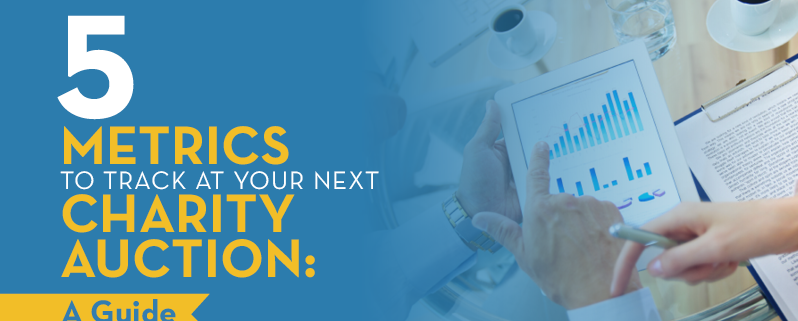5 Metrics to Track at Your Next Charity Auction: A Guide
Hosting a charity auction is no easy feat. With so many moving parts, from procuring items to reserving a venue, your nonprofit has to set aside ample time to prepare, execute, and reflect on your fundraiser. A critical part of this process is tracking performance metrics.
Once you’ve set goals for your charity auction, tracking metrics before, during, and after your auction is a surefire way to assess your progress and modify your strategies. Metrics can give your nonprofit invaluable insight into how to maximize its ROI and leverage your events to drive higher engagement. By collecting data, you’ll be in a better position to adjust your approach and optimize your auction strategy in the future.
To make the most out of your next charity auction and future auctions, you’ll need to pay close attention to the following metrics:
These data analytics can help you compile a list of strengths and weaknesses and find room for improvement. Then, you can revamp your fundraising strategy to drive revenue and meet your fundraising goals! Let’s dive in.
Demographics
Understanding your target audience is pivotal to executing a successful charity auction. You’ll need to collect information about your supporters ahead of time so you can tailor your marketing strategy to them.
An important demographic metric to look at is the average age of your target attendee. By understanding your target audience’s age, you can advertise your auction on platforms where supporters are most likely to see it. For instance, Facebook is great for older generations, while TikTok and Instagram tend to appeal more towards Generation Z and Millenials.
As people begin to register for your event, take a look at demographic breakdowns like age, gender, geographic location, and other relevant factors. This will provide you with invaluable insight into the best ways to reach your target audience and create hype around your event so attendees come ready to bid!
Plus, you can use this information to guide your item procurement strategies. For example, if your target audience is typically parents, you can offer more family-friendly packages bound to inspire bids.
Nonprofit involvement
You’ll also want to track supporters’ past involvement with your organization, such as looking at how frequently supporters give and the average donation amount. This can be done with your donor data management platform by creating donor profiles and tracking overall trends.
Donors’ past involvement will help you better understand your registrants’ budget and how much they’re comfortable giving to your organization. As a result, you can procure auction items that fit their giving capacity so your nonprofit can maximize fundraising.
For example, if your target attendees typically do not give large donations to your organization, choose cost-friendly items that donors are likely to bid on. According to the OneCause guide to charity auction ideas, popular auction items that are budget-friendly for your organization and its supporters include:
- Gift baskets
- Day in the life experiences
- Local coupons
- Nonprofit merchandise
If you’ve held an auction in the past, you can also look at metrics like the average bidding amount and number of bids per item. This will help you understand the items that most appeal to your target audience, ensuring that all of your items get a substantial amount of bids. You’ll also want to track these same metrics at your upcoming charity auction so you have this insight for future events.
Conversion rate
Before your charity auction, you’ll need a multichannel marketing campaign to increase excitement over your event and boost the number of registrants. For example, your organization might choose to promote your charity auction on the following platforms:
- Social media
- Your nonprofit’s website
Each of these platforms have their own analytics that are helpful to track in order to assess your marketing performance. For example, you can track open and read rate with email, number of likes and comments on social media, and incoming organic traffic to your nonprofit’s event landing page.
However, the most notable metric you want to pay attention to before your event is marketing conversion rate. Conversion rate is the percentage of people who take the intended next action after seeing your marketing content. This could be the number of people that donate to your auction ahead of the event or register to attend.
Conversion rate can help you adjust your marketing strategies to create more effective marketing materials. For example, let’s say that your nonprofit sees a low conversion rate with emails that promote registration for your next charity auction. As a result, you can modify your segmentation strategy, the frequency at which you send your emails, or make your call to action stronger. Experiment with different strategies to increase conversions and boost excitement over your event!
During the event itself, you can look at the conversions, or how many bids are placed, for your auction items. This information can then be broken down into average number of bids per item or per guest, which items attracted the most amount of bids, and which items attracted the least amount of bids. These insights will allow you to strengthen your item procurement strategy for the future.
Retention rate
Once you’ve held your auction, take a deep dive into how many people attended and donated toward your fundraising event for the first time, and how many people were recurring attendees. Retention rate helps your nonprofit understand how effective your charity auction was at engaging past supporters and maintaining their interest in your organization.
While donor retention and acquisition are both effective ways for nonprofits to bolster their fundraising strategy, donor retention is more cost effective and essential to building a reliable donation pipeline. If you’re seeing low retention rates, consider how you can deepen your connections with existing supporters to boost their participation.
For example, you can modify your communication strategies with more personalized emails, invite existing supporters to an exclusive in-person component of your hybrid auction, or be more explicit about the impact of recurring donations in your marketing materials.
Fundraising ROI
Another important metric to track after your auction wraps up is your return on investment (ROI). ROI may sound like an oxymoron for nonprofits but trust it’s important to track!
Your nonprofit likely invested a lot of funding into hosting an auction, whether through investing in online fundraising software, booking catering, or creating marketing materials. Once you’ve wrapped up your fundraiser, determine whether you made back the money you put into the event and extra to power your mission.
A high ROI is a great indicator that your auction was a success. If you’re running at a loss or merely breaking even, your nonprofit has to do more in the future to use budget-friendly planning strategies and increase event revenue.
One way your nonprofit can save funds is by partnering with a local company. According to 360MatchPro’s guide to corporate philanthropy, a business can help you by offering in-kind donations for auction items and packages or providing financial support. Your nonprofit can partner with a local restaurant to offer a free dining experience or coupon booklet as one of your auction items. This will save your nonprofit money so you can boost your ROI.
Collecting data is the best way to assess your nonprofit’s fundraising progress and determine how you can improve your strategies for the future. After you collect these metrics, take the time to review them so you can build a clear roadmap for future auctions. Remember to share relevant metrics, like your total funds raised, with your nonprofit’s audience so they understand the impact of their contributions and are more likely to give again.




